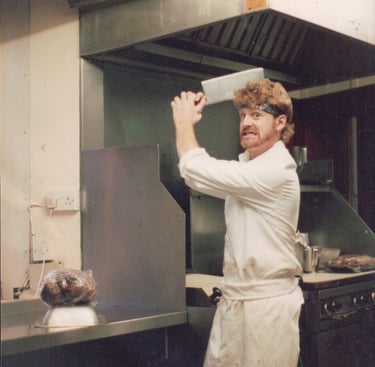

Trainer Mike cooking haggis in Scotland
Cooking up a Communicative Classroom
As a teacher trainer, I often get asked how teachers can make their classes more communicative with their learners. As a gourmet chef, it dawned on me that I could cook up a communicative meal for any teacher with a recipe of ingredients from words that begin with “co”.
First of all, any good language teacher knows that there are four conditions necessary to learning. These four Conditions should be the top menu items coming out of our language kitchen. They include: (1) exposing students to language; (2) getting them to use the language; (3) providing language instruction; and (4) motivating them.
Let’s start with our appetizer: (1) language exposure or input, which will require some “co-ingredients” such as contextualization. Contextualization is a picture that the learner can see, or imagine themselves in. We need to convince our learners they are in that situation. Think about it. When you communicate in another new language yourself, it’s not just words and sounds that create meaning – but the situation itself.
Core material is another spice we need to sprinkle into our communicative input dish: exposing our students to the target language many times.
To top off the meal, we need to throw in some complexity. Our learners should be challenged with language more complex than they know. They need to work to get the tender meat off our lesson plans.
For the main course, (2) we need to get our students using the language, the output. Heading to our “co” spice-rack,, let’s throw in some context –- unrehearsed. I see so many language learners just mimicking voices or reading texts aloud. Such a bland dish! A good communicative language chef will instead have learners use unrehearsed language so they build the new language with their existing language.
Other key ingredients for this output meal include cooperation, community and couples. If students only use the language with the teacher, it rules out natural use. A good teacher builds a class community, encourages peer interaction and does pair work. This helps students to feel more at ease with the language.
Finally, throw in spoonfuls of communicative activities – heaps if you can. We’re talking role-plays, simulations, debates, discussions, information gaps and class mingles.
What about our third condition … (3) a little language instruction side-dish? Well, if we’re going to cook up some classroom guidance with our “co” ingredients, we’ll need coaching & counseling. A good language chef shows learners, but doesn’t do it for them. This can embarrass our language students if we’re constantly jumping in and providing answers for the students. In my years as a chef and observing thousands of teachers, patience and tolerance is the best ability for both professions.
We should also build students’ confidence by telling them what they are doing right, as well as wrong.
Correction is also a necessary spice to our guidance plate. We don’t want errors to become habitual or fossilized. That said, a good teacher corrects but a great teacher knows when not to correct.
Finally, -- and this ingredient is hard to find in teachers – we need to contain not control student behavior. Afraid of noise? But you’re a language teacher, so get rid of that fear! Good teachers “contain” disruptive behavior so class activities continue, not try and control every aspect. If you’ve got 80-90% of the class participating, don’t put your head in the oven trying to discipline that other 10-20%.
And now for dessert with our final condition: (4) motivating our language learners. Our first co-ingredient is providing a competitive and collaborative balance to motivate our learners. Children love the competitive edge, which most teachers cook up in games. However a more creative language chef adds a little competition to almost any activity (“Will the boys finish the handout today before the girls?”). But too much competition can discourage some learners. Good teachers also plan collaborative activities where language students can motivate each other.
Now, let’s throw into our motivational pot some connection as well. If learners feel connected to the context and language, they will be motivated. Personalize that plan!
Finally, sprinkle on top a little consideration, and remove any confrontation with students. If you are too authoritative and distant, motivation will fall. Be considerate of their feelings and respect them like we want them to respect us teachers. If learners refuse to do something, negotiate with them to do part of an activity, don’t take the “my way or the highway” attitude.
Create these four conditional dishes, with the co-ingredients in the recipes, and you’ll build a communicative classroom fit for a good language feast!
